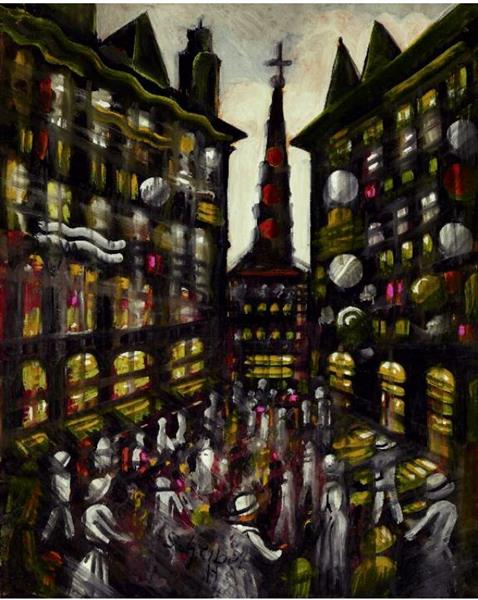Description
The work "Nagyvárosi Forgatag" by Hugó Scheiber is a vibrant and dynamic representation of urban life that stands out for its complex composition and its palette of intense colors. Scheiber, an outstanding representative of the Hungarian Expressionist Movement, captures in this painting the essence of the city bustle, showing a parade of energetic figures that are intertwined in an environment full of activity. The painting, whose title translates as "the bustle of the city", reflects the modernity and frantic rhythm of urban life in the context of the Hungarian of the twentieth century.
In an initial observation, which impacts the viewer is the bold use of color. The work is impregnated with a chromatic range rich in warm and cold tones, ranging from yellow and orange to blue and green. This diversity of colors not only establishes an attractive visual contrast, but also gives life to the scene, transmitting an almost palpable sensation of movement. The colors apply with a loose technique that allows the brushstrokes to be visible, revealing the gesture of the artist and its emotional connection with the canvas.
The composition of "Nagyvárosi Forgatag" is dense and complex. In the foreground, a group of human figures seems to move towards the viewer, creating a sensation of immediacy and energy. Each figure is presented schematically, with fluid contours that suggest speed and dynamism. In the distance, the buildings and other architectural elements blur, leading the observer's gaze to the bottom, where a horizon is perceived that evokes the urban environment of the city.
Although the figures in the painting are stylized representations and do not appear in a photographic detail, their variety in the position and gesture contribute to the visual narrative of the work. There is a crowd, with some people walking, others chatting, which suggests the daily interactions of the vast social network that characterizes urban life. This invites us to reflect on solidarity and loneliness that can coexist in the same city.
An aspect that deserves mention is the influence of French art on Scheiber's work, particularly Fauvism, which is characterized by the bold and innovative use of color. The way Scheiber combines the shape and color can remind us of artists such as Henri Matisse or André Derain, although always maintaining a clear link with its Hungarian cultural context. This synthesis of styles is a reflection of the artistic dialogue that was given in Europe at that time and demonstrates Scheiber's talent to embrace and integrate various influences in his work.
It is also important to place Scheiber within his time. He grew at a time of significant social and political transformations in Hungary, which had an impact on his art. "Nagyvárosi Forgatag" not only represents a moment of urban bustle, but also encapsulates the anxieties and hopes of a society instead, reflecting the modernity that emerged in Europe.
The work "Nagyvárosi Forgatag" offers us a window to a world full of life, color and movement, while inviting us to unlearn and reconsider our own experiences in the urban environment. In an era where the rhythm of life can be overwhelming, this painting stands as a powerful reminder of the beauty found in the daily bustle and in the intense energy of our cities. Thus, the work of Hugó Scheiber becomes a celebration of the human being in its most vibrant and complex context.
KUADROS ©, a famous paint on your wall.
Hand-made oil painting reproductions, with the quality of professional artists and the distinctive seal of KUADROS ©.
Art reproduction service with satisfaction guarantee. If you are not completely satisfied with the replica of your painting, we refund your money 100%.

